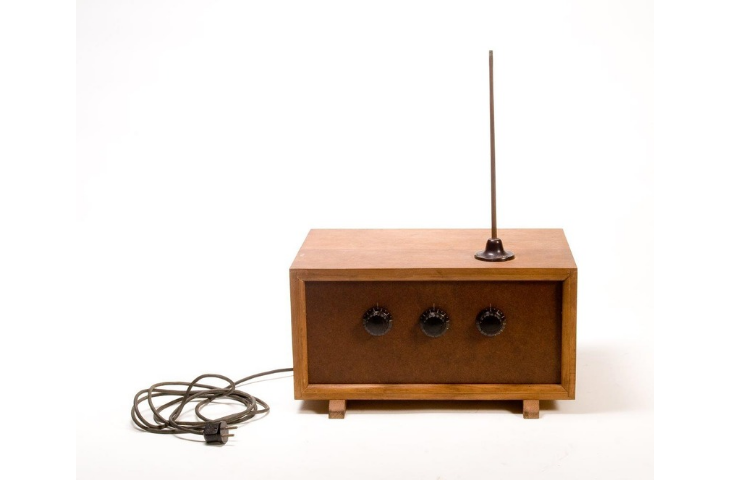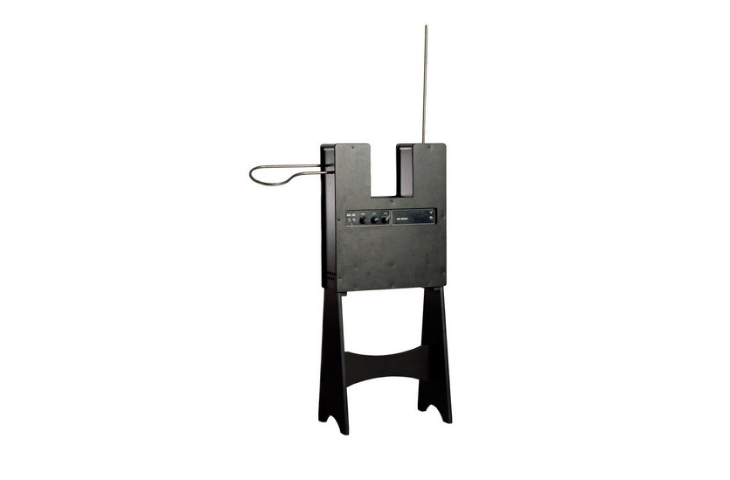June 2024
Fig.1

Theremin, author unknown, Brussels, 1957-1967, inv. 4331
Fig.2

Theremin, Big Briar, United States, 1991, inv. 1997.031
The theremin: a pioneer of electronic music
The theremin is an electronic instrument invented by Russian engineer Lev Termen (1896–1993). It made its debut in 1920 and is today widely regarded as the first electronic musical instrument.
To play the theremin, you do not touch the instrument. By moving your hand closer to or farther from the vertical antenna, you change the pitch. The horizontal antenna controls the volume. The theremin works on the heterodyne principle, meaning the audible signal is the result of mixing two basic frequencies. These are produced by two oscillators that generate ultrasonic tones (inaudible to the human ear). One frequency is fixed, the other is variable, depending on the movement of the performer's hand. What we hear is the difference between these two frequencies.
From Soviet invention to American adventure
Vladimir Lenin saw potential in the theremin and sent Termen on a promotional tour across Russia. To demonstrate what communism could achieve scientifically and technically, he was also sent to present his invention in England, France, and especially Germany. In 1927, Termen arrived in New York, where he stayed until 1938 - the year he mysteriously vanished.
In the United States, Termen and his theremin attracted a loyal following. Not only musicians and composers, but also scientists and even the US government showed interest in both the musical-technical possibilities of the instrument and in Termen’s engineering talent. On commission from the Federal Bureau of Prisons, Termen even built a metal detector for Alcatraz prison.
Commercial disappointment, artistic legacy
In 1928, Termen patented the theremin in the US and granted the commercial production rights to RCA. Despite high hopes, the project ended in failure. RCA’s marketing claims that the theremin was easy to play did not convince the public. Only a few musicians mastered its playing technique. Among them were Lucie Bigelow Rosen, Samuel Hoffman, and especially Clara Rockmore, Termen’s protégé.
Before World War II, little original music was written for the theremin. Its repertoire mainly consisted of arrangements of well-known classical pieces, such as The Swan by Camille Saint-Saëns.
Revival through film and pop music
After Termen’s departure in 1938, public interest in the theremin faded. His ambition to introduce it as a new instrument in art music proved unsuccessful. Yet the instrument did not vanish into obscurity. Its survival is due to two musical genres in which it enjoyed a revival after World War II: film and popular music.
The theremin made its film debut in 1945 in Spellbound and The Lost Weekend, where it was used to express anxiety, tension, and emotional disturbance. But its most iconic association is with outer space. The sounds of the theremin (and other electronic instruments) proved ideal for evoking the infinity of space, evil Martians, and flying UFOs. Rocketship X-M (1950) was the first sci-fi film to feature a theremin. Others followed, including The Day the Earth Stood Still (1951) and It Came from Outer Space (1953).
The breakthrough in pop music came in 1966 with Good Vibrations by The Beach Boys. Strictly speaking, this was not a true theremin but an electro-theremin built by Paul Tanner[1]. Later on, artists like Frank Zappa, Jimmy Page (Led Zeppelin), and Brian Jones (The Rolling Stones) also used the theremin in their music.
[1] While the electro-theremin resembled the theremin in timbre, its design was different. Inside the instrument was a pitch knob connected by a string to an external slider. Moving the slider changed the pitch. Thanks to frets - like on a guitar - it was easier to play precise notes.
The theremin at the MIM
The MIM owns two theremins. The instrument with inventory number 4331 (fig. 1) was built between 1957 and 1968 by a technician from the “Studio de Musique Électronique (de Bruxelles)”, also known as “Studio Apelac”. It was assembled following the guidelines of German engineer Joachim Winckelmann, who in 1933 wrote a 32-page manual on how to build your own theremin at home, published in the Deutsche Radio-Bücherei series.
The second theremin (fig. 2) was built by Big Briar, the company founded by Robert Moog—the godfather of the synthesizer—in 1978. Moog built his first theremin at the age of 15, and by 19 he had started his first company, R.A. Moog Co. He initially sold theremin parts as DIY kits, and later fully assembled instruments.
Text: Wim Verhulst